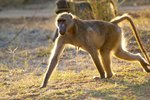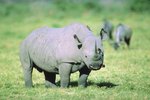
The world of wildebeests is made up of two species, both of which come from Africa. These two species are blue wildebeests (Connochaetes taurinus) and black wildebeests (Connochaetes gnou). These sizable antelope both consume herbivorous diets. Grass is a big food staple for both species. Blue wildebeests are also frequently referred to as common wildebeests.
Blue Wildebeest Diet
Blue wildebeests rely heavily on grasses for their meals. Colonial grasses are a particular favorite for them. In times of scant available grasses, they usually subsist on foliage from trees and shrubs. When they can't find suitable sustenance, they move great distances in search of it. Migration occurs in massive herds of thousands of wildebeests. Blue wildebeests feed succulent plants, too.
Black Wildebeest Diet
Like their blue wildebeest kin, black wildebeests eat grass. They regularly dine on leaves taken from shrubs and bushes, but to a lesser degree than grass. They appreciate grassveld regions, which are areas that are home to a wide assortment of natural plants. Unlike blue wildebeests, black wildebeests don't migrate in search of food.
Water Intake in Blue Wildebeests
Although the prospects of finding food often push common wildebeests to relocate to different areas, the same applies to water. Their quests are often greatly fueled by finding water. They typically drink it twice daily.
Water Intake in Black Wildebeests
Proximity to water is also a factor for black wildebeests, although to a lesser degree than blue wildebeests. Black wildebeests generally reside in grassy, airy regions that are close to water sources. Despite that, they are capable of surviving more than 24 hours without water. Their bodies are used to living in dry environments.
Spotting Blue Wildebeests
Blue wildebeests inhabit grasslands, woodlands and savannas of African nations such as Zimbabwe, Namibia, Tanzania and Botswana. Adult blue wildebeests typically weigh between 260 and 595 pounds, with grayish coats.
Spotting Black Wildebeests
Grassy areas are the natural living environments of black wildebeests, too. They live in countries including South Africa, Swaziland and Lesotho. Mature specimens usually weigh between 242 and 346 pounds. Their coats not only are denser than those of the common wildebeests, they're also deeper in color -- with blackish or brown tones. One big difference between the two African wildebeests is that black wildebeests have white tails, and blue wildebeests have black ones.
References
- African Wildlife Foundation: Wildebeest
- National Geographic: Wildebeest
- IUCN Red List of Threatened Species: Connochaetes Taurinus
- University of Michigan Animal Diversity Web: Connochaetes Taurinus
- Kruger National Park: Blue Wildebeest
- University of Michigan Animal Diversity Web: Connochaetes Gnou
- Kruger National Park: Black Wildebeest
- IUCN Red List of Threatened Species: Connochaetes Gnou
- Newquay Zoo: Black Wildebeest
- PBS Nature: Blue Wildebeest
Resources
Photo Credits
-
Comstock/Stockbyte/Getty Images



